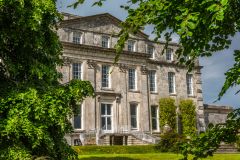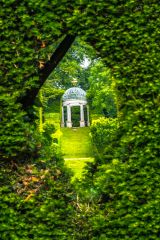
History
In 1717 George Pitt built an early Georgian country house in the Frome Valley, just 2 miles from the county town of Dorchester. The house was made of red brick, but when George III saw it he expressed his dislike of the style, saying with disapproval, 'Brick, Mr Pitt, only brick'. Pitt promptly had the brick house encased in Portland stone.

Novelist Thomas Hardy was a near neighbour and knew the house well. He used Kingston Maurward as the model for Knapwater House in his 1871 novel Desperate Remedies.
The house itself is not open to the public. Part of the house is now used by Kingston Maurward College, offering courses in horticulture and agriculture, and in the grounds stands the Tudor mansion of Maurward Manor House, built in 1590.
Like the main house, the manor is privately owned and is not open to the public. A plaque on the wall surrounding the manor tells us that George Singer was born here in 1847. Singer made his fortune from sewing machines but also manufactured cycles and cars, and served three times as Lord Mayor of Coventry.
The gardens surrounding the Georgian house were laid out in the 18th century in traditional English landscape garden style popularised by Capability Brown, with sweeping lawns dotted with carefully arranged trees to create sudden vistas, and classical follies used to create focal points.
A Grecian temple acts as the setting for the National Collection of hardy salvias. The temple was built atop a mound built so that Pitt could survey the building work on his new house. The raised mound offers a magnificent view of the garden and the surrounding countryside, and also looks down on a croquet lawn where local players were enjoying themselves when I visited. What a setting for a game of croquet!

Even older than the 18th century landscaped garden is an Elizabethan walled garden, built to provide food to the 16th-century manor house. Brick walls follow the contours of the sloping site, and the garden is divided into rectangular beds divided by turf paths.
There are colourful magnolias in spring, clipped topiary in fanciful shapes, a Japanese garden, a double herbaceous border and summer bedding displays.
In the Edwardian period, a new 35-acre formal garden was added by the Hanbury family, with yew hedges enclosing stone terraces, and garden 'rooms' in Arts and Crafts style. The Edwardian garden is laid out as a series of long axes, leading through themed areas including a Red Garden, a Mediterranean Border, Terrace Border, and Brick Garden.
Each garden room has a central feature, or focal point, such as a statue or quiet pool. Each garden room has a unique character and is designed to provide year-long colour and blend harmoniously with the less formal 18th-century landscape.
The gardens are kept in top shape by a team of full-time gardeners aided by students from the college's horticultural course.
A more recent addition at Kingston Maurward is a rare breed animal park. It is designed primarily for students in the college's Animal Care programme, but visitors can meet the animals up close and see some unusual breeds.
Visiting
I visited Kingston Maurward on a dismal grey day in June, but despite the weather, the gardens were a delight. Even the 10 minutes I had to shelter under a convenient tree from a sudden downpour was made enjoyable by the beautiful setting. Do take the time to wander around the lake laid out by Capability Brown.
From the far side of the lake, you catch glimpses of Pitt's mansion house reflected in the waters of the lake, while swans swim placidly by. It really is a magnificent sight. One oddity is a modern sculpture of an arm rising up out of the lake bearing a sword, representing the legend of the Lady of the Lake in Arthurian legend.








 We've 'tagged' this attraction information to help you find related historic attractions and learn more about major time periods mentioned.
We've 'tagged' this attraction information to help you find related historic attractions and learn more about major time periods mentioned.




